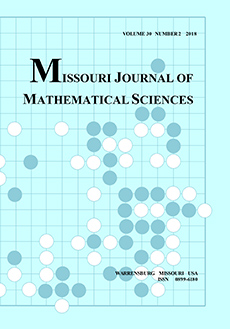Abstract
Given a complex-valued polynomial of the form $p(z) = (z-1)^k(z-r_1)^m(z-r_2)^n$ with $|r_1|=|r_2|=1$; $k,m,n \in \mathbb{N}$ and $m \neq n$, where are the critical points? The Gauss-Lucas Theorem guarantees that the critical points of such a polynomial will lie within the unit disk. This paper further explores the location and structure of these critical points. Surprisingly, the unit disk contains two ‘desert’ regions in which critical points cannot occur, and each $c$ inside the unit disk and outside of the desert regions is the critical point of exactly two such polynomials.
Citation
Christopher Frayer. "Geometry of Polynomials with Three Roots." Missouri J. Math. Sci. 29 (2) 161 - 175, November 2017. https://doi.org/10.35834/mjms/1513306828
Information




